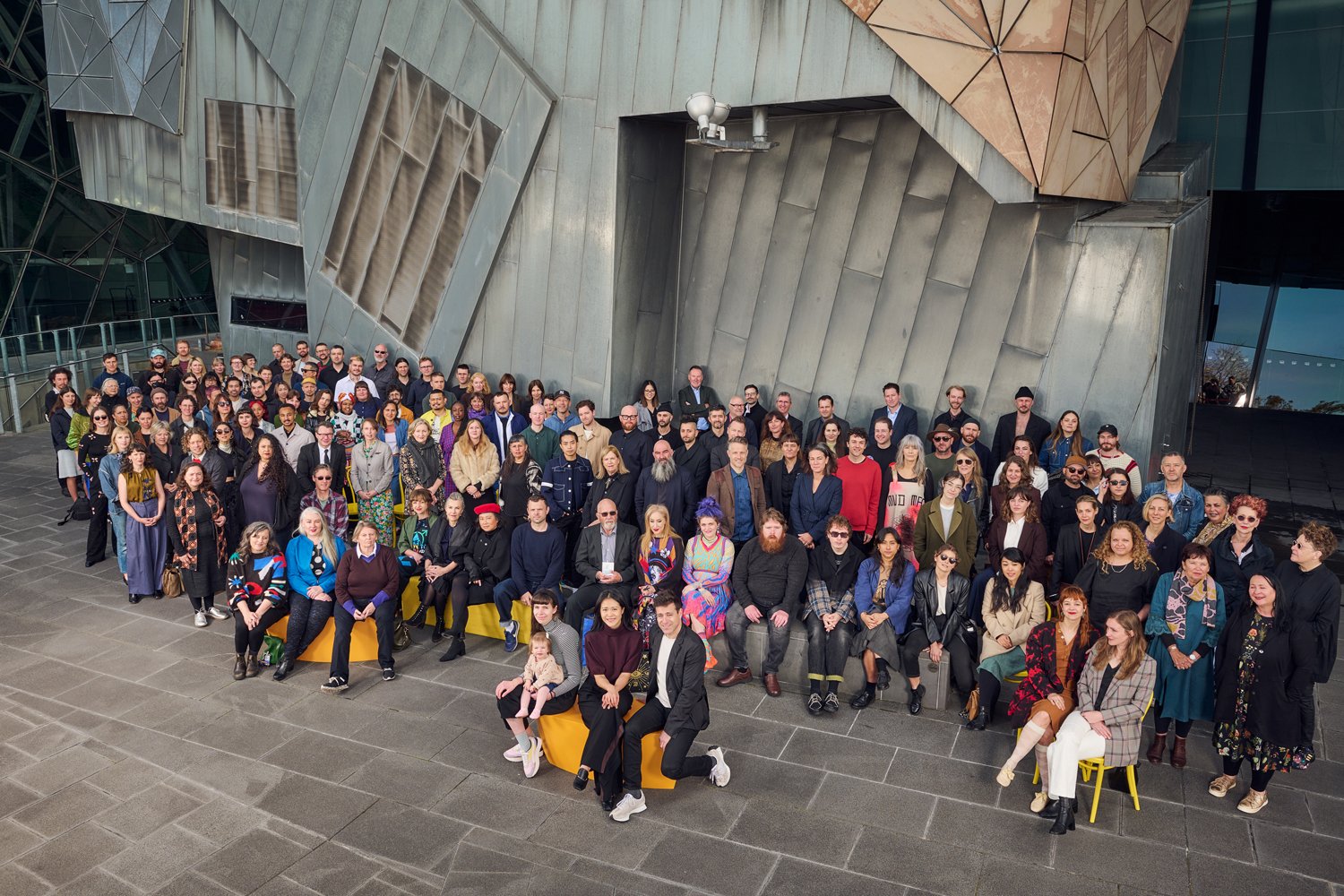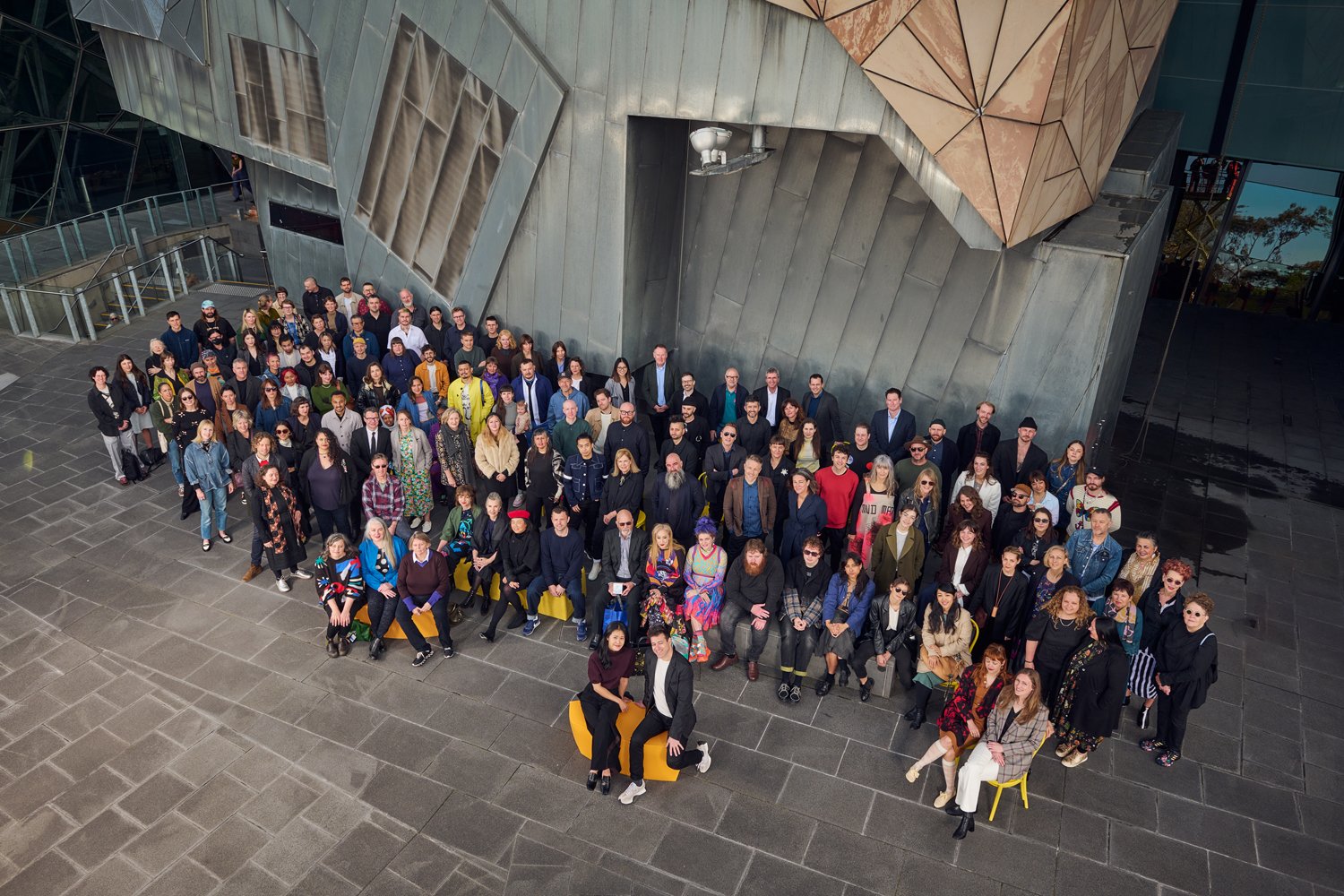The beginning

The remaking of things
Gracia Haby & Louise Jennison
NGV commission for Melbourne Now 2023
The Ian Potter Centre: NGV Australia
Friday 24th March – Sunday 20th August, 2023
We’re overjoyed, utterly, to be a part of the forthcoming Melbourne Now 2023 which “will be displayed throughout all levels of The Ian Potter Centre: NGV Australia, including permanent collection galleries, showcasing new works and commissions by emerging, mid-career and senior practitioners as well as local collectives”[i].
For our part, we will be making a green pocket of restored eucalyptus forest habitat collaged with pieces from the collection of the NGV. A forest in which you can watch night turn to day and day turn to night.
‘Our’ forest is growing in readiness for March of next year, under the watchful eyes of Lenni, Arthur, and Lottie, but we’ve barely reached the mid canopy.
We’re making a giant 35-metre collage which will be illuminated so that it transitions from golden mornings and green days to nocturnal blues. A forest, similar in feel to Bracketed by light (2022) and Something Reverberated (2021), and building upon the scale and method explored earlier within Ripples in the Open (2018–2019), to create our largest ever all-encompassing installation, The remaking of things.
By making the work about restored habitat, we are looking forward, not backward. Focusing not on what we had and have lost, but on what we need to move ahead: grow habitat, protect biodiversity, reciprocate with nature.
Excitingly, we will be using the NGV collection to grow something new and hopeful: habitat for the Grey-headed flying foxes, in particular, by the banks of the Birrarung.
The closest camp of Grey-headed flying foxes is Yarra Bend, and in March, when the exhibition is on, they will be flying out in their larger summer numbers in search of nectar, pollen, and fruit. In our role as wildlife carers, it is also the same time that the flying fox pups who will have been in our care throughout season (typically September through March) will be taking their first flights with the Yarra Bend colony. With them, with luck, Albert and Errol, two recent wildlife rescues.
We’re delighted to meld these two things together even more so. And we are looking forward to sharing our process, now that the big reveal has been.
Within the collage you will be able to see a microbat (A New South Wales bat, c. 1800s), the smallest and only bat, mega or micro, we could find in the collection (out of copyright, and not including First Nations). You’ll be able to see elements from Grace Cossington Smith’s Bottlebrushes (1935) and Kuringai Avenue (1943), incorporated with permission from the estate, alongside a Kookaburra and a Cockatoo by F. E. Striezel from a pair of panels c. 1915.
You will also be able to recognise several photographs by Nicholas Caire, including Scene on the Yarra, Healesville (c. 1876–1880s) and Scene on the Yarra at Yarra Doon (c. 1876–1880s), and J. W. Lindt’s Giant eucalypts, Acheron River, Victoria (1899). Wildflowers, too, from Anne Paulson’s Sketches of Victorian bush flowers (c. 1861) and Fanny Anne Charsley (The wildflowers around Melbourne, series 1867) will grow from the floor, alongside gum-flowers and ‘love’ (c. 1860) by Louisa Anne Meredith. Well, that’s the detailed plan at least. We’ve still months to go.
A keen eye will be able to detect Richard Bunbury’s Green Native Fuschia, Victoria (1844), a Kangaroo Paperweight (c. 1900) by William Drummond & co., and a digital, of course, cutting of James Sowerby’s Eucalyptus robusta 1794–1795 plate 13 from A Specimen of the Botany of New Holland by James Edward Smith, published by James Sowerby, London 1794–1795, vol. 4.
We’re hoping to find a home within the foliage for A. Shelden’s Possum and banksia (1920s), and a Variegated Warbler (Variegated Fairy-wren) (c. 1804–1806) by John Lewin. With more to come as we fill in the layers from background to foreground, thinking of the pieces like a theatre set. So far, each of the large pieces in the background, being 5-metres high, take around six hours to cut out, depending upon how many small leaves there are.
Enlivening our collage further, there will be a sound component, in time with the lighting sweep. A twenty-four minute loop, representing twenty-four hours in the colony some ten-minutes drive from our house, we hope it will make it feel like you are within the hug of the colony.
It has been such an incredible experience to have access to the collection, and the many people who care for it, to create a forest suitable for the Grey-headed flying foxes we so love and need, and their wild and wonderful ‘friends’.
Please contact Bev Brown of Bat Rescue Bayside (@bat_rescue_bayside), Victoria, if you find an injured bat.
0402 347 557
batrescuebayside.org.au
Please note: you need to be a qualified, vaccinated carer to handle bats.
[i] “Celebrating new and ambitious local art and design, Melbourne Now will cross a range of contemporary disciplines including fashion and jewellery, painting, sculpture, architecture, ceramics, video, performance, printmaking and publishing. The inaugural 2013 exhibition was an unprecedented survey of some of the most exciting local contemporary practitioners. Ten years on, Melbourne Now 2023 will again highlight the latest art, architecture, design, and cultural practice shaping Melbourne. A cornerstone of the first Melbourne Now, Community Hall will return as a space to gather, connect and celebrate Melbourne’s diverse and creative communities, as well as popular NGV Kids interactive projects. Bold in scale, Melbourne Now will be displayed throughout all levels of The Ian Potter Centre: NGV Australia, including permanent collection galleries, showcasing new works and commissions by emerging, mid-career and senior practitioners as well as local collectives.” Melbourne Now, NGV, https://www.ngv.vic.gov.au/exhibition/melbourne-now-2023/, accessed 2nd November, 2022.
Image credit: Gracia Haby & Louise Jennison, Bracketed by light (detail), 2022, artists’ book (of small illuminations of crepuscular and nocturnal inhabitants, and one or two besides)
























